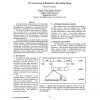Free Online Productivity Tools
i2Speak
i2Symbol
i2OCR
iTex2Img
iWeb2Print
iWeb2Shot
i2Type
iPdf2Split
iPdf2Merge
i2Bopomofo
i2Arabic
i2Style
i2Image
i2PDF
iLatex2Rtf
Sci2ools
VL
1992
IEEE
1992
IEEE
The Conversion of Diagrams to Knowledge Bases
If future electronic documents are to be truly useful, we must devise ways to automatically turn them into knowledgebases. In particular, we must be able to do this for diagrams. This paper discussesbiological diagrams. We describe the three major aspects of diagrams: visual salience, domain conventions and pragmatics. We next describe the organization of diagrams into informational and substrate components. The latter are typically collections of objects related by Generalized Equivalence Relations. To analyze diagrams, we define Graphics Constraint Grammars (GCGs) that can be used for both syntacticand semantic analysis. Each grammar rule describes a rule object and consists of a Production, describing the constituents of the object, Constraints that must hold between the constituents and Propagators that build properties of the rule object from the constituents. We discuss how a mix of Darsing and constraint satisfaction 2. A biological diagram example The example chosen for this d...
Future Electronic Documents | Paper Discussesbiological Diagrams | Rule Object | Visual Languages | VL 1992 |
| Added | 11 Aug 2010 |
| Updated | 11 Aug 2010 |
| Type | Conference |
| Year | 1992 |
| Where | VL |
| Authors | Robert P. Futrelle |
Comments (0)

